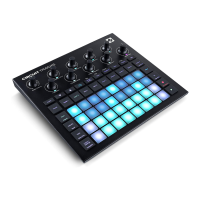56 57
The selected sync rate is indicated by the brightly-lit pad: the default rate is “x1” (pad 5 in row 3),
which means the track will play at the set BPM. Selection of a higher-numbered pad increases the
rate at which the play cursor progresses through the Pattern relative to the previous one. Similarly
the lower-numbered pads will decrease the play rate. The sync rates available are 1/4, 1/4T, 1/8, 1/8T,
1/16, 1/16T, 1/32, 1/32T, with T representing triplets.
1/16 is the default sync rate, where each step corresponds to a 16th note. Increasing the sync rate is
a great way to increase the sequencer’s step resolution at the cost of overall playback time. Reducing
the sync rate is useful for creating longer patterns that don’t require quite as fine detail, such as long,
evolving pads.
If the sync rate is changed in Play Mode, the Pattern always completes the current cycle at the
existing rate, and changes to the new rate at the end of the cycle. This applies regardless of the
current Pattern length or Step Page selection.
Mutate
Mutate is a feature that lets you introduce further random variations into individual Patterns on a per-
track basis. Mutate “shuffles” the notes or hits in the current Pattern, to different steps. The number of
notes/hits in the Pattern, and the synth notes or drum samples themselves are both unchanged, they
are merely reassigned to different steps. All step parameters are reassigned by Mutate, including micro
steps, gate values, sample flips, probability and automation data.
To mutate a Pattern, hold Shift
20
and press Duplicate
18
. You can do this in any View that has a
Pattern steps display, i.e., Note View, Velocity View, Gate View or Pattern Settings View. Mutate only
affects the Pattern currently playing, so if it is part of a Pattern Chain, the other Patterns in the chain
will be unaffected. The reassignment of notes/hits will take account of the Step Page length. You can
apply Mutate as many times as you wish for any one Pattern by repeatedly pressing Shift + Duplicate:
the notes/hits in the Pattern will be randomly reassigned each time.
Note that Mutate cannot be “undone”; it is a good idea to save the original Project so that you can
return to it after applying Mutate.

